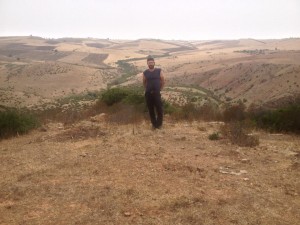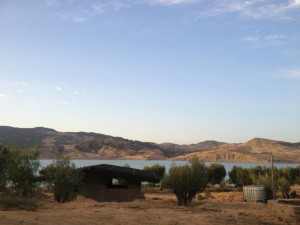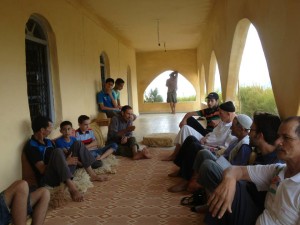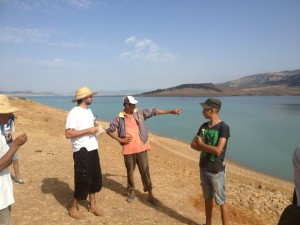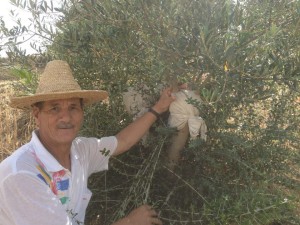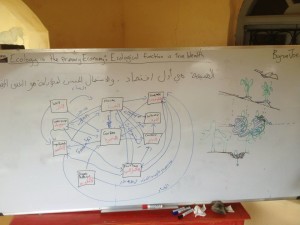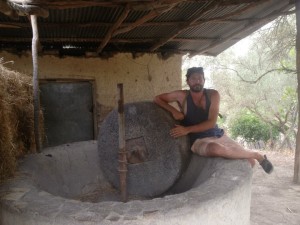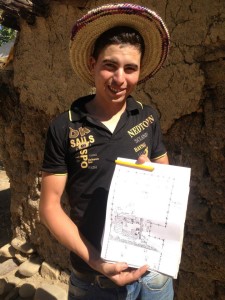A LESSON IN IDENTITY
Return To Morocco, 2015
I’ve recently had the good fortune to have spent 3 weeks travelling through northern Morocco teaching and consulting for the Morocco Integral group. I had some interesting and ultimately very exciting and rewarding experiences. The following is a very informal writing on those experiences. Please excuse the format. It is not meant to be essayist but more of a lose journaling. I also don’t mean for it to come across as a “hooray-for-Byron” piece, but I’ve been encouraged by what happened and hope to see it grow further.
I was asked to provide two courses, seven days each on ‘practical permaculture’ for villages in the region of the Riff Mountains. It sounded simple enough and shorter than a Permaculture Design Course(PDC) but as I got down to constructing a curriculum I realised without a thorough understanding of the context of the people attending much of my proposed curriculum could be all but useless, so I did what I could but still left a lot of room for the spontaneous arising of relevant discussion etc.
The village of Ouled Hamou with lake Al Wahda in background.
For the months and weeks leading up to the course I was having deep misgivings about me, a (kinda) young guy from middle class, Western Australia(“The Lucky Country”) travelling across the globe to teach an ancient, rural people about ANYTHING practical. It just didn’t feel right. However the guys organising the course assured me that the people there needed assistance as much as anywhere and that they had faith in my abilities(I had worked with them before). Fast forward to my arrival and as I approached the farm around sunset after about 35 hours of travelling I viewed the harsh, dry, all but barren hills of the region and my heart sunk. “What on earth am I going to be able to offer to these folk? Who do I think I am… I should’ve listened to Dad and been an accountant”. I went to bed jet lagged and disheartened thinking to myself how I really needed to understand their context foremost…
The course began at 8:30am the next day. I had about 20 villagers plus farm staff and a young British family there. I remembered back to when I had assisted another Permaculture teacher in providing the same people with a PDC three years earlier. Some in that previous course(mostly the westerners who had travelled there) had appreciated the PDC material but the majority of the villagers had largely seen it as abstraction and next to no replication/implementation had occurred in the village since. So I looked at my proposed curriculum for the day… ‘Permaculture Principles’, ‘Design Thinking’ etc and quite spontaneously decided I was going another route. I introduced myself to the group and explained who I was, my background, my work, why it was I was now standing in front of them and what I hoped we could achieve. Then I asked them about THEM. Who were they? How did they refer to themselves? Do they identify tribally, regionally, nationally? How do they make a living? At first they seemed reluctant but soon they seemed to enjoy the fact that an outsider was taking a keen interest in Who They Are(they don’t ever get tourist there. Ever.) By the end of the day they were eagerly sharing greater details in their ideas of themselves as individuals, families, village, region etc. and I had barely mentioned the word Permaculture.
One of the classrooms
I reflected that night as I lay in my tent about what had occurred and decided that we should continue the same line of inquiry the next day. The next morning I asked them about their local identity and practices through time. We explored the difference between how they and their parents generation made a living and livelihood. We explored how their grandparents had done it, how their people had lived in the region before the French occupation and we went as far back as to explore the few sources that suggest north Africa was a very different place last millennium. When Alexander the Great arrived it was far more forested, greener and generally much higher in bio-diversity than today. Lion, elephant, rhino, hippo, lynx… Morocco and north Africa at large was a kind of melding(an ecological edge between…) European and African(sub-Saharan) biomes.
As it goes, lake Al Wahda, the huge lake that their village is situated upon was once a fertile valley in which the people grew thousands of acres of fruit trees(mainly citrus) intercropped with wheat, vegetables and ran their animals. However in the early 80s the Moroccan government had built a hydro-electric plant far down stream and had dammed the valley thus ending the relatively fruitful way of life that the people of the region had known. Since then it seems they have experienced the cultural disorientation so common amongst peoples who’s way of life is abruptly and dramatically changed. They were still catching up with figuring out how to be who they were without their traditional land uses… Obviously these were things that they had already known about themselves but having them objectify the events and hear themselves speak their own cultural experience seemed to have a clarifying effect on their grasp of their collective identity.
Villagers with lake Al Wahda in background. Note the lack of vegetation on the hillsides.
I asked them if they would describe the changes in their way of life as positive or negative. They all said that while they enjoy the benefits of the electricity the dam provides the socio-cultural, agricultural and ecological changes they have witnessed are decidedly negative. Their growing dependancy on external inputs, the socially degrading effects of television, poorer and poorer pasture, erosion, the recent mass introduction of GM wheat seed(this is a huge issue) and the resulting crash in yield etc…
The older gentlemen appeared visibly relieved and vindicated to see me, an outsider aware and appreciative of the slow death of their collective health and happiness. Some had been watching the incremental(and sometimes abrupt) changes for 70+ years but had not had the means to properly express their heartache… and the youth, like so many around the world, were quick to dismiss it as the jaded ramblings of an outdated era. When I noticed this dynamic I did my best to implore the younger attendees to listen to their elders and explore and embrace the practices of their ancestors.
On day three I presented the group with a slide show on Mediterranean climate regions of the world, initiating the mornings discussion which was to lead the group to think beyond their village. The people of the region have no formal education and their ideas of the world beyond come largely through the 1 or 2 television channels they receive(not the highest quality content).
To me one of the most impacting points of the whole course was when the penny dropped as to their position within the greater, modern, global(chaotic) context. Having already spent so much time exploring their story I guided them into a discussion of the state of the world at large and the immense changes that virtually all peoples have experienced. We looked at traditional peoples pre and post the industrial revolution and pre and post WWI&2. I showed them images of Romanian villagers from the 1890s, dressed in traditional garb, completely unique to that region of the world. We looked at images of native peoples from Bolivia the 1900s, people from Bali, Nigeria, Sweden and we discussed the many, varied and beautifully unique cultural forms that have developed around the world, born of the relationship between a people and their land over prodigious time… And then I showed them recent pictures, mainly of young people from all those countries, all wearing the same clothes. At Starbucks. On their smart-phones. We discussed how the loss of a species is considered such a tragedy(and rightly so) and I suggested that the loss of these traditional human cultural forms, the degrading of what anthropologist Wade Davis calls the ‘ethnosphere’ was also not only deeply tragic but dangerous.
The many, varied and valuable relicts of traditional Human cultures, practical, ceremonial and otherwise that reflect our specie’s inherent ingenuity. For the Human animal the loss of these cultural forms can be as dangerous as that of an important food species. They are the software by which we navigate the world, they are our Art of Living and without them we are as infants wandering all but blind through the world. Thanks to the well oiled machine of the industrial global empire these cultural artefacts are increasingly threatened as they are disposed with in favour of tacky, mass-produced conveniences.
We then went back over some of the forms they have lost.
Traditional Mediterranean peasant techniques for grafting onto wild rootstocks.
The next morning we finally discussed ecology. I wrote on the board(in both English and Arabic) “ECOLOGY IS THE PRIMARY ECONOMY: ECOLOGICAL FUNCTION IS TRUE WEALTH”. We would return to these axioms frequently. I really wanted this to sink in as a primary truism. Despite being very rural and still a semi-traditional people they are all but obsessed with money. Almost all mental equations they make are in the form of money. So I began to introduce the concept of Energetic Accounting/Ecological Literacy and seeing money as just one more energy(albeit the only imaginary one). A major point for me was for them to really get that the fuller and healthier their ecosystem’s function, the better their life experience. With this I was able to better leverage the elder’s memories and experiences of life when their land was healthier and use it as a means to catch the attention of the youth.
An example of household energy/nutrient flow.
“Ecology is the primary economy – ecological function is true wealth.”
I introduced the Atrophy<Sustainability>Regeneration spectrum and referencing their own observations of ecological/agri-cultural degradation(evermore erosion, poor yields, silted water etc) we cemented their appreciation for it. I used the ‘leaky bucket’ analogy and clarified how nature regenerates by ’catching and storing energy’ and that currently most human systems atrophy from immense energy leaks. We explored how money is just one form of energy, the cultural energy of human exchange and very importantly we clarified how relative to other usable energy forms(water, gravity, light, heat, biomass, fuels etc) money is in fact imaginary. We observed how the region receives adequate rainfall(~700mm/yr) but that it is no longer being caught and stored, that life can never really catch and store energy forever but that by slowing it down it can be used with greatest efficiency, metabolised if you will…
We spent almost an entire morning discussing Ecological Succession and returned to it frequently. It was a very valuable lesson as much of their landscape is teetering between primary and secondary succession at any given point.
The quickest of glances with a half trained eye could see that the entire region was in serious need of some beneficial animal impact and so we spent time covering the principles behind the ecology and grazing as described in Holistic Management. We covered the main differences between ‘set-stocking’ and intensive, rotational grazing, ‘predator/prey relationship’ and beneficial disturbance, plant recovery, the Brittle Spectrum etc. This was a MAJOR aha! moment for them. After careful explanation they digested the basics and they became very enthusiastic. I suggested that they think about changing their current ‘set-stocking’ methods and asking the institute(Morocco Integral) if they could begin training and practice in HM grazing techniques(more on this later).
Finally, after lunch that day we began on Permaculture Principles. We covered many and how they could apply to them. We then listed all their weekly/monthly/annual inputs, products, bi-products and wastes. This really helped to cement the notion of how dependant they have become upon externalities. We then created a basic flow diagram charting the how energies and resources(no such thing as waste!) could ideally flow through an average village homestead. Very clarifying.
Once, every village used their own, traditional beast-driven olive press.
After all this, on day 4 we began to tour some homes sites in the village and started our design projects. I could see how with some work(but mostly different thinking) their very quaint but severely degraded and dry village could become an extremely abundant, resilient and beautiful settlement… and I shared with them that vision and the processes that could take them there. By now the villagers were super enthusiastic and over the remaining few days we fleshed out zone 1-2 designs for a handful of village homesteads(much to the disappointment of those we didn’t have time for!).
Young villager, Useph returns to class having done his own site plan for his homestead, unprompted.
The directors and staff at the institute have been amazed by the change they have witnessed in the villagers during and since the course. For 3 years the institute has been providing courses and resources to the people of the village in hope that they would appreciate the opportunity and then apply and reproduce what they are shown. Frustratingly they hadn’t done so. This is a common theme within these types of projects. One or two people will catch the bug and become involved but there is often a huge lag in any significant number becoming enthused and active.
At the beginning of my time there there was a current of scepticism and even subtle distrust from many of the villagers, however as the days went on this began to shift. The youth began to return to class having done their own site plans, unprompted. Now Im told that since the course, those that didn’t do it wish they had. And there is a great air of enthusiasm amongst them.
When I first suggested that set-stocking was a major, regional affliction they were sceptical and almost offended. We went through the ecology behind HM grazing and I returned to it may times daily until it sunk in. Now there is great and increasing enthusiasm from the villagers to combine their animals into a flerd(a mixed flock/herd) and collectively graze on a beneficial schedule. Last week I got this message from one of the directors…
“3 days ago we counted 50 cows, 70 sheep and more than 20 other animals grazing on the farm. Today, there were 170-180. I will indeed take a picture so you get to believe i!’’
Amazingly I have been told that as a direct result of the course they are holding sittings to discuss reinstating their old, abandoned traditional common law system that has been in disuse for generations. In fact only the most elderly have memory of it in practice. It is similar to the Amish system by which the whole village will come together to complete a large project in a relatively short time. With this system in place coupled with good design and a genuine understanding of the principles behind it they could do amazing work.
I believe I was drawn into this new course outline for a number of reasons. One, my training in HM and the great import it places upon Context. Two, my use of and admiration for the Regrarian Platform and it’s recognition of how important Mental Climate and Psycography/Demography are. Three, my appreciation for ‘story’ as presented by Warren Brush. Four, my relatively recent exploration into my own cultural heritage, common law etc found me naturally curious about their deeper identity. Five, my genuine fear of being perceived as a western-missionary charlatan type come to spread the word and ‘save’ people. This saw a deep, genuine desire to get to know THEM as thoroughly as possible in order to be of greatest service to them instead of just delivering a one-size-fits-all, pre-packaged routine. I must also mention the unexpected assistance I received from Hassan Tarif, my good friend from the Sahara who has been on a journey into regenerative agricultural studies for some years now, Ahmed Arrousi, a Moroccan Arabic/English translator with a deep, keen mind and background in the subjects and to Raphael Hannequin, the french landscape designer associated with Morocco Integral whose input on all things landscape design proved beyond valuable.
I will be looking into how to better refine the process I initiated. It helped them make the connection between the story of their history and the fact that it is mirrored around the world. And of course taking this deeper dive into their context made me far more capable of effecting real change. While a PDC is flexible enough to accommodate for different locations, teaching styles etc. those Ive seen taught have largely been quite ‘universal’ and not so focussed on a people in a place with a context. That can work very well in a developed area with a cosmopolitan audience, but for those times and places where one is addressing a rural, agrarian peoples not long removed from their traditional ways of life and not so exposed to global concepts, I think we should be really re-thinking our approach. I have now seen first hand how how superfluous it is to spend days on end teaching (in this case) northern Moroccan villagers about The Humid Tropics, Humid Cool To Cold Climates, Pattern Understanding etc. They themselves asked the purpose and validity of doing so. At least in an introductory course. There are other pennies that need to drop first.
Beyond techniques and strategies this work is a matter of identity and relationship. Once people remember Who The Really Are in relationship to themselves, each other and the world it is a natural and inevitable response for them to act with love and great enthusiasm for healing.
A very special thanks goes out to Olivier Vuillemin and Driss Benabjeljelil for having me back to their beautiful farm and always showing me such hospitality, to Raphael Hannequin for his invaluable contributions in design thinking and to Hassan Tarif and Ahmed Alami Aroussi for their assistance as translators which was made all the more effective given that they are both familiar with permaculture and regen. ag. principles… and to the villagers of Ouled Hammou for welcoming me into their lives so intimately.
~ Byron Joel
© Byron Joel, Oak Tree Designs, 2016
